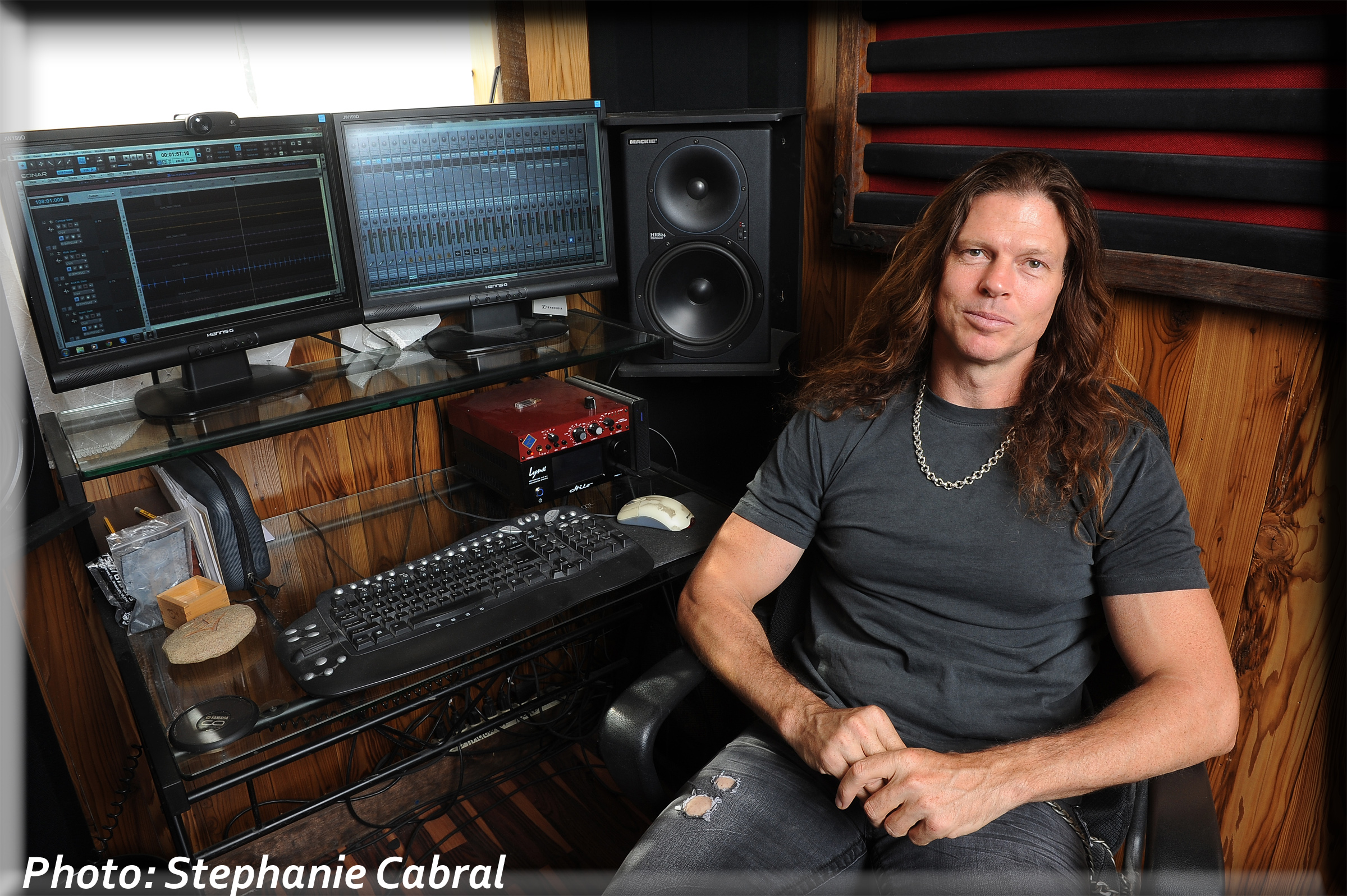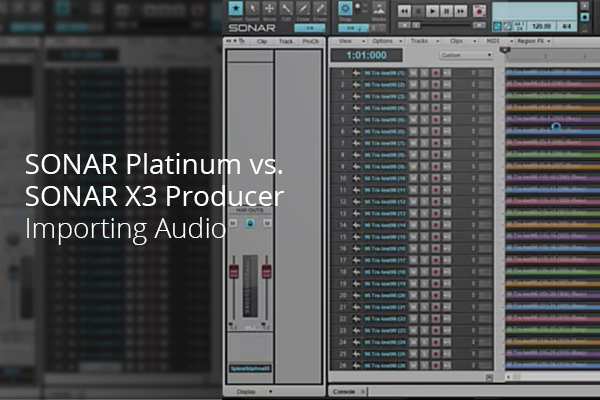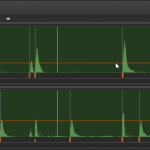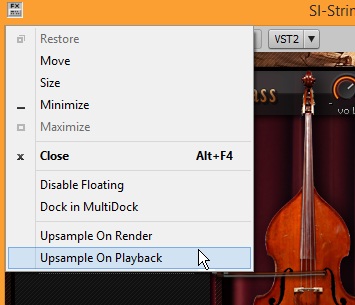Check out the latest episode of Cakewalk Talk, where Dan Gonzalez interviews audio engineer Daniel Rowland (Adrian Belew, StudioBelew, Accept) about LANDR and his role at the company.
We’ve posted a shorter cut below as well.
Check out the latest episode of Cakewalk Talk, where Dan Gonzalez interviews audio engineer Daniel Rowland (Adrian Belew, StudioBelew, Accept) about LANDR and his role at the company.
We’ve posted a shorter cut below as well.
Thanks to Melodyne’s advanced tempo detection and SONAR’s powerful ARA drag-and-drop integration, your projects can now follow a live recording’s tempo. Simply drag a standard audio clip (or Melodyne region effect) to SONAR’s timeline, and SONAR creates a tempo map that follows the clip tempo. Watch the new video for more information.

While there have been hundreds of fixes and enhancements added to SONAR since X3, we’ve compiled this list of the ones we think X-Series users will be particularly fond of.
 Chris Broderick has been focusing on his band Act of Defiance and their new record on Metal Blade Records. “We recorded all vocals, cello, lead, rhythm, classical and acoustic guitars at Ill-Fated Studio’s in Los Angeles, CA on SONAR Platinum. The features we gained upgrading from X3 to Platinum really helped us capture this new record.”
Chris Broderick has been focusing on his band Act of Defiance and their new record on Metal Blade Records. “We recorded all vocals, cello, lead, rhythm, classical and acoustic guitars at Ill-Fated Studio’s in Los Angeles, CA on SONAR Platinum. The features we gained upgrading from X3 to Platinum really helped us capture this new record.”
 Norman Matthew of the band Murder FM not only used Platinum on his recent record produced by Beau Hill, but his band is also using it live on tour. “Platinum is ridiculously stable. Our show has developed into something more dynamic–and we like triggering some sounds that we used on the record on tour. SONAR Platinum works so well for us on stage as well as in the studio.”
Norman Matthew of the band Murder FM not only used Platinum on his recent record produced by Beau Hill, but his band is also using it live on tour. “Platinum is ridiculously stable. Our show has developed into something more dynamic–and we like triggering some sounds that we used on the record on tour. SONAR Platinum works so well for us on stage as well as in the studio.”
 Javier Colon, winner of NBC’s The Voice continues his lifelong musical journey with a new record deal and album coming out on Concord Music Group this spring. “I’ve been using SONAR for a long time, but going from X3 to Platinum was the best upgrade I’ve had. Platinum was like a writing partner for me with this new record.”
Javier Colon, winner of NBC’s The Voice continues his lifelong musical journey with a new record deal and album coming out on Concord Music Group this spring. “I’ve been using SONAR for a long time, but going from X3 to Platinum was the best upgrade I’ve had. Platinum was like a writing partner for me with this new record.”
UPDATE: Results are in! Here’s the answer key:

It was a very tight race, but the clear winner was Track 3 (so there is definitely still plenty of room in this world for professional mastering houses).
In 2nd place was Track 5, which was followed extremely narrowly by the LANDR masters, where Track 4 beat Track 2 by almost nothing. Track 6 was next, and Track 1 was last.
Note: These masters were intentionally not level-matched, as we believe that for a song of this style, the resultant level was part of the criteria for the quality of the masters. We will be doing another one of these tests in the future, wherein the levels will all be matched.
What do you think? Do these results surprise you?
 We thought it would be fun to have a blind mastering taste-test and include LANDR. Below is a track from a project I Co-wrote/recorded/produced/mixed compliments of a great artist from Finland by the name of Peppina.
We thought it would be fun to have a blind mastering taste-test and include LANDR. Below is a track from a project I Co-wrote/recorded/produced/mixed compliments of a great artist from Finland by the name of Peppina.
Track 1 is the actual pre-master, and then the following tracks are masters rendered by different means.
One of these tracks (the one that is actually on the record) is mastered by a prominent mastering house/engineer in NYC.
A few also may be rendered with different LANDR settings 😉
One is also mastered using all in-house Cakewalk plug-ins…
Below these tracks you will find a survey, please vote for your favorite “master” and leave any general comments.
Results will be posted in 2 weeks.
Create your own user feedback survey

A few weeks back, we released this video demonstrating the drastic speed improvement when inserting 100 blank audio tracks into the current edition of SONAR.
If you saw that video, you’ll recall that SONAR Platinum, in less than one second, accomplished what SONAR X3 took about 13 seconds to complete — a 2,600% improvement!
As we continue to make improvements to SONAR Platinum (and Artist & Professional as well) through Rolling Updates, we thought it might be fun to race SONAR Platinum against SONAR X3 Producer in their ability to import actual audio files.
The video below, complete with drag race audio, a rock n’ roll soundtrack, and a couple of millisecond-accurate stopwatches, places SONAR Platinum and SONAR X3 Producer side-by-side to see who is the real speed demon.
I’ll spoil it a little and tell you that SONAR Platinum is the winner here, but the illustrated difference in speed may truly shock you!
Note: If you liked the soundtrack, be sure to check out the Rock Guitar Anthems loop pack!
A few years back, we showed you a bit about Parallel Compression in SONAR. Now that we’ve introduced Patch Points in the Jamaica Plain update, you can do these same things with a much more efficient workflow.
Let’s quickly define parallel processing: In parallel processing, a signal is duplicated into two or more signals. Each copy of the signal is processed differently but plays back simultaneously with the original. The copy/copies are then mixed together.
Parallel Compression, aka “New York Compression,” is most commonly used on drums to add body to the drum mix without flattening the snappy transients.
Check out the video below to see just how easy (and great sounding) this technique can be:
| You might also like… | |
|---|---|
 |
 |
| 5 TOOLS TO GET “THAT ANALOG SOUND” FROM SONAR | UNIVERSAL ROUTING TECHNOLOGY 202: THE AUX TRACK |

As we work to perfect SONAR, we’ve focused not only on useful new features, but also improvements to the core program. This month, we targeted our efforts on streamlining SONAR in major ways that will help hobbyists and power users alike.
For the upcoming SONAR Kingston update, CTO Noel Borthwick ran a few benchmark tests to compare, apples-to-apples, exactly how much better SONAR is performing now versus SONAR X3. In every case, the SONAR Kingston update showed marked improvements over SONAR X3 to perform the most common tasks.

Want to feel the effects of this progress for yourself? Upgrade or try SONAR free today.
SONAR is officially supported on Windows 7, 8, 8.1, and 10.
| You might also like… | |
|---|---|
 |
 |
| ANATOMY OF A SONAR PROJECT: REPLACING THE PLACEHOLDER | 5 WAYS SONAR’S ROLLING UPDATES ARE WORKING FOR YOU |
 In-demand LA Producer Luigie “Lugo” Gonzalez is in the trenches on a daily basis depending on SONAR to deliver radio-ready masters to major labels. As an advocate of this year’s Rolling Updates, and especially the new Universal Routing Technology [URT] in SONAR, Luigie told us how he is initially using URT:
In-demand LA Producer Luigie “Lugo” Gonzalez is in the trenches on a daily basis depending on SONAR to deliver radio-ready masters to major labels. As an advocate of this year’s Rolling Updates, and especially the new Universal Routing Technology [URT] in SONAR, Luigie told us how he is initially using URT:
CW Artist Relations: What are you currently working on?
Luigie: Right now I am in the middle of a few projects as always. Universal artist Ah Moon is being released right now and thankfully turning some heads. It’s actually Burmese which is very interesting. I am also working tracks with DJ Shift and the new single “Painkiller” is dropping at radio in the next month depending on the label.
CW Artist Relations: In general, what are your thoughts on SONAR’s updates this year?
Luigie: Every release has been rock solid. Honestly though, at first, I was reluctant. I have to have a stable platform because I am constantly delivering, and one technological mishap could be disastrous. Cakewalk is onto something with the monthly updates. Every release has been better and more efficient. I haven’t had any problems with stability, and I really look forward to the new features every month. Every release so far has been great, but this month’s Jamaica Plain release was a game-changer for me with the new Patch Points and Aux tracks
 CW Artist Relations: How are you using Patch Points and Aux Tracks?
CW Artist Relations: How are you using Patch Points and Aux Tracks?
Luigie: I’m already using them a lot, and I am already hearing a difference in my mixes from the different ways I can control things. The possibilities of what I am going to be able to do creatively will be endless really, but right now I am primarily using them for control in a few different ways. I use VCA’s, and I do a lot of layering in general, so having the ability to route kick layers and synth layers helps me balance signals so that I don’t overload my channels. It’s basically giving me a lot more control in general. One specific example using Patch Points is when I use Turnado, Stutter edit or any other special effects. Now I can use Patch Points to affect only the signals I want without affecting a whole bus; but rather just the tracks I route to the new patch point.
CW Artist Relations: What else comes to mind for new features that you are using?
Luigie: I have to say, upsampling is one of my favorite features as well! Now having it on playback is even better! Sometimes you hear the difference, and sometimes not… But that’s because not all plugins support up-sampling, and some already do by default. There are instances where it actually helps a lot and you can certainly hear it especially when I use fancy EQing on the reverb returns. In some cases, I’ve noticed about a 20% improvement on my mixes. They tend to have more air, depth and clarity when I take advantage of upsampling.
Click here for more information on SONAR Jamaica Plain Release
Click here to try SONAR for fee
By Craig Anderton
Some plug-ins and virtual instruments sound better when recording at sample rates higher than 44.1/48 kHz because high audio frequencies can interfere with lower clock frequencies, which causes foldover distortion. This adds a “wooliness” at lower frequencies, and can also compromise high-frequency response. Plug-ins that include internal oversampling do not have this problem, but not all plug-ins—particularly older ones—use oversampling.
The Foxboro update introduced Upsample on Render, which provides the benefits of using higher sample rate processing even in 44.1 kHz or 48 kHz projects by internally 2X up-sampling plug-ins of your choice, rendering them as audio, then down-sampling the rendered audio back down to the original sample rate. While it may seem counter-intuitive that the audio quality from rendering at 96 kHz is preserved at lower sample rates, the lower sample rates have no problem reproducing signals in the audio range, and by rendering at 96 kHz, the problematic frequencies no longer exist.
The Jamaica Plain update now offers Upsample on Playback, so you can preview and compare the difference in real time. To enable either Upsampling on Render or Upsampling on Playback on a per-plug-in basis, click the FX button to the left of the instrument name in the virtual instrument interface.

To turn Upsampling on or off globally for plug-ins that have Upsampling enabled, use the 2X button in the Control Bar’s Mix module.